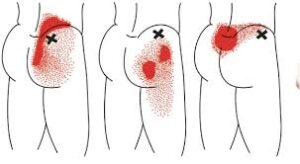
One of the most important causes of anterior knee pain
- 2019-09-13
- 19 Likes
- 701 Views
- 0 Comments
Prevalence and sensitivity of trigger points in lumbo-pelvic-hip muscles in patients with patellofemoral pain syndrome
Mahbobeh Samani a, Farahnaz Ghaffarinejad b, Sara Abolahrari-Shirazi b
Tahereh Khodadadi c, Fatemeh Roshan c
a Student Research Committee, School of Rehabilitation Sciences, Shiraz University of Medical Sciences, Shiraz, Iran
b Ph.D., Department of Physical Therapy, School of Rehabilitation Sciences, Shiraz University of Medical Sciences, Shiraz, Iran
c BS, Department of Physical Therapy, School of Rehabilitation Sciences, Shiraz University of Medical Sciences, Shiraz, Iran
a b s t r a c t
Objectives: Changes in the activity of the lumbo-pelvic-hip muscles have been established as a major cause of patellofemoral pain syndrome (PFPS), a common orthopedic problem. The present study aimed to compare the prevalence and sensitivity of myofascial trigger points (MTrPs) in lumbo-pelvic-hip muscles in persons with and without PFPS.
Methods: Thirty women with PFPS and 30 healthy women 18e40 years old were recruited for this study. The prevalence of MTrPs was assessed by palpation, and pressure algometry was used to measure the pressure pain threshold. This study evaluated the areas where MTrPs are most commonly found in the lumbar muscles (internal oblique, erector spinae and quadratus lumborum), pelvic muscles (gluteus maximus, gluteus medius, gluteus minimus and piriformis), and hip muscles (hip adductor, quadriceps, hamstring, tensor fascia lata and sartorius). Independent t-tests we
re used to compare mean pressure pain thresholds between the two groups. Chi-squared tests were used to compare the prevalence of MTrPs.
Results: The prevalence of MTrPs was significantly higher in most of the lumbo-pelvic-hip muscles in patients with PFPS compared to healthy persons. However, there were no significant differences between groups in the prevalence of MTrPs in the gluteus minimus or adductor muscles. The pressure pain threshold in lumbo-pelvic-hip muscles was lower in patients with PFPS compared to healthy participants.
Conclusion: In patients with PFPS the prevalence of MTrPs in the lumbo-pelvic-hip region was higher, and the pressure pain threshold was lower, than in
healthy people. Thus thera
py to treat PFPS should target the lumbo-pelvic-hip muscles.
1. Background
Patellofemoral pain syndrome (PFPS) is a common source of anterior knee pain, which predominantly affects young female patients (O’Sullivan and Popelas, 2005). Although the main cause of PFPS is still unclear (Nijs et al., 2006), patellar maltracking as a result of imbalance in the vastus medialis obliques and vastus lateralisis the most likely mechanism (Fagan and Delahunt, 2008). Another assumed etiology of PFPS is impaired function of proximal structures such as the lumbo-pelvic-hip muscles (Aminaka et al., 2011; Biabanimoghadam et al., 2016; Cowan et al., 2009). Several stu
dies have found that patients with PFPS have impaired lumbo-pelvic-hip muscle function as a result or cause of PFPS, a finding supported by Motealleh et al., (2015), Cowan et al., (2009), Robinson and Nee (Robinson and Nee, 2007), Piva et al., (2005), and Ireland et al., (2003). One possible cause of impaired lumbo-pelvic-hip muscle function is the formation of myofascial trigger points (MTrPs). These are described as hyperirritable spots in the fascia surrounding skeletal muscles, that elicit local pain and refer it to another region (Kanner, 2003). Trigger points may result from or be exacerbated by trauma, overuse, mechanical overload, postural faults, or psychological stress (Jafri, 2014). The presence of MTrPs in muscles results in impaired motor function and motor control (Lucas et al., 2010), as well as decreased muscle tone and muscle strength (Kanner, 2003). Therefore, the presence of MTrPs in lumbo-pelvic-hip muscles may impair proximal stability via the mechanisms noted above. Proximal instability, in turn, can lead to impaired muscle function in the lower extremities and consequent exacerbation of PFPS (Brumitt, 2009). Thus, the evidence appears to support that therapists should target the lumbo-pelvic-hip region in the treatment of PFPS (Ellenbecker, 2000). However, due to the large number of lower extremity and lumbar muscles, and the high frequency of MTrPs in these regions, not all MTrPs may need to be treated during therapy. To the best of our knowledge, there is no evidence regarding the most common MTrPs located in the lumbo-pelvic-hip muscles. Evidence of the relative prevalences of MTrPs in different locations would help therapists to target them during treatment, yet most available studies evaluated the prevalence of MTrPs in hip muscles. Therefore, the present study aimed to compare the prevalence of MTrPs in different lumbo-pelvic-hip muscles in patients with PFPS compared to healthy persons.


Leave Your Comment